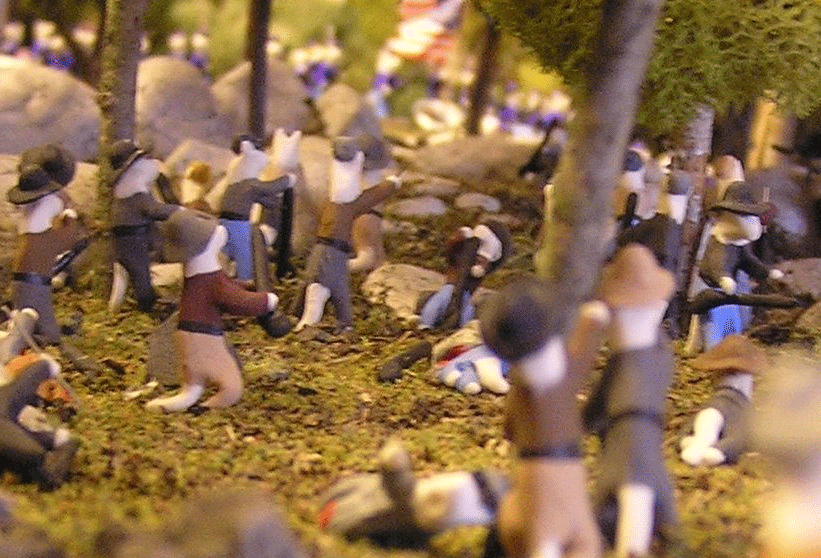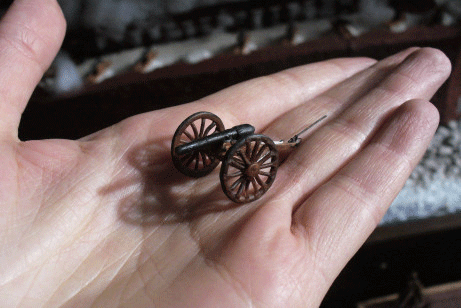Civil War Tails
See the History

Newly-opened in Gettysburg, Civil War Tails at the Homestead Diorama Museum features unique dioramas of various Civil War scenes. What makes them unique? Twin sisters Ruth and Rebecca Brown hand-sculpt every figure and build most of the diorama features from scratch. And, in a quirky touch of whimsical charm, every soldier is a cat. But the most important aspect of what makes the dioramas unique is their solid grounding in history.
Each cat represents one soldier, not ten or twenty. Features such as artillery, uniforms, and even rocks are reproduced with accurate detail. All of this combines to present each scene in a way that helps the viewer see what it would have looked like over 150 years ago.

But is all the attention to detail worth it? Isn’t a diorama just a diorama?
What Ruth and Rebecca find most interesting about building the dioramas of Civil War Tails is that it allows them to make connections and piece together details of the past. This results in dioramas that are intimately connected to the stories of the historical men and women who are portrayed.
During Pickett’s Charge at Gettysburg, the 72nd Pennsylvania Regiment was brought up to bolster the Union line at the Angle. As they topped the ridge, they came face to face with chaos. Confederates were nearing the stone wall, the 71st Pennsylvania had retreated, and Lt. Cushing’s two remaining cannons were desperately firing treble canister. The 72nd halted on the crest and began firing. What followed has been a puzzlement, both to their fellow soldiers and to historians.
The regiment remained where they were, silhouetted against the sky, ignoring all orders and pleas to charge—even from their brigadier general. Even when the Confederates poured over the wall, the 72nd refused to move. Lt. Haskell, a staff officer, tried to make them advance, and was frustrated and dumbfounded when they refused.
When Rebecca first designed the diorama of the fighting in the Angle, she was perplexed, just as Lt. Haskell, Brig. Gen. Webb, and historians have been. But then further reading suggested that the diorama needed over 900 Confederates added along the wall. Nearly all of Pickett’s division would be on the diorama—and in the 72nd Pennsylvania’s front—by the point in time depicted. Suddenly, the 72nd is not just facing a couple hundred Confederates who crossed the wall. Now they are facing at least two brigades—quite possibly three times their number. Suddenly, it makes sense why they would have had second thoughts about advancing.
Sometimes making a diorama helps piece together bits of information in a new way. At Fort Sumter, the Confederates took photos of the fort immediately after the surrender. In one photo, there is a jumble of wreckage in the foreground, commonly identified as a gun dismounted by a Confederate shot. As Rebecca was making and placing the guns on the diorama, she used the photo and a National Park Service diagram to decipher the wreckage and found that it belonged to a 10-inch Columbiad and a howitzer.
Meanwhile, Ruth was reading the story of two sergeants who grew frustrated with firing the smaller guns in the safety of the lower level. They snuck up to the top tier of the fort and fired a 10-inch Columbiad. Since it would have taken six men to roll it forward again, they fired a second shot with the gun still in the recoiled position. The gun flipped over, dismounted a howitzer next to it, and nearly went down the stair tower.

Piecing together Ruth’s research and Rebecca’s work with the photo and NPS diagram, we can see that the Confederate photographers actually captured the guns mentioned in the story of the sergeants. What’s more, because of the photo, we can know exactly what the wreckage looked like. Making the diorama helped to piece together separate facts which may not have been connected before.
That is the beauty of the dioramas at Civil War Tails—through them, you can see the stories of the men and women of the Civil War. And it is their stories that help us relate to history, to feel what they felt and to see that they were no different than we are.
Check out the museum’s website at www.CivilWarTails.com and the next time you are in Gettysburg, stop by Civil War Tails. See the history and be inspired by the stories of determination, love, desperation, and valor.


